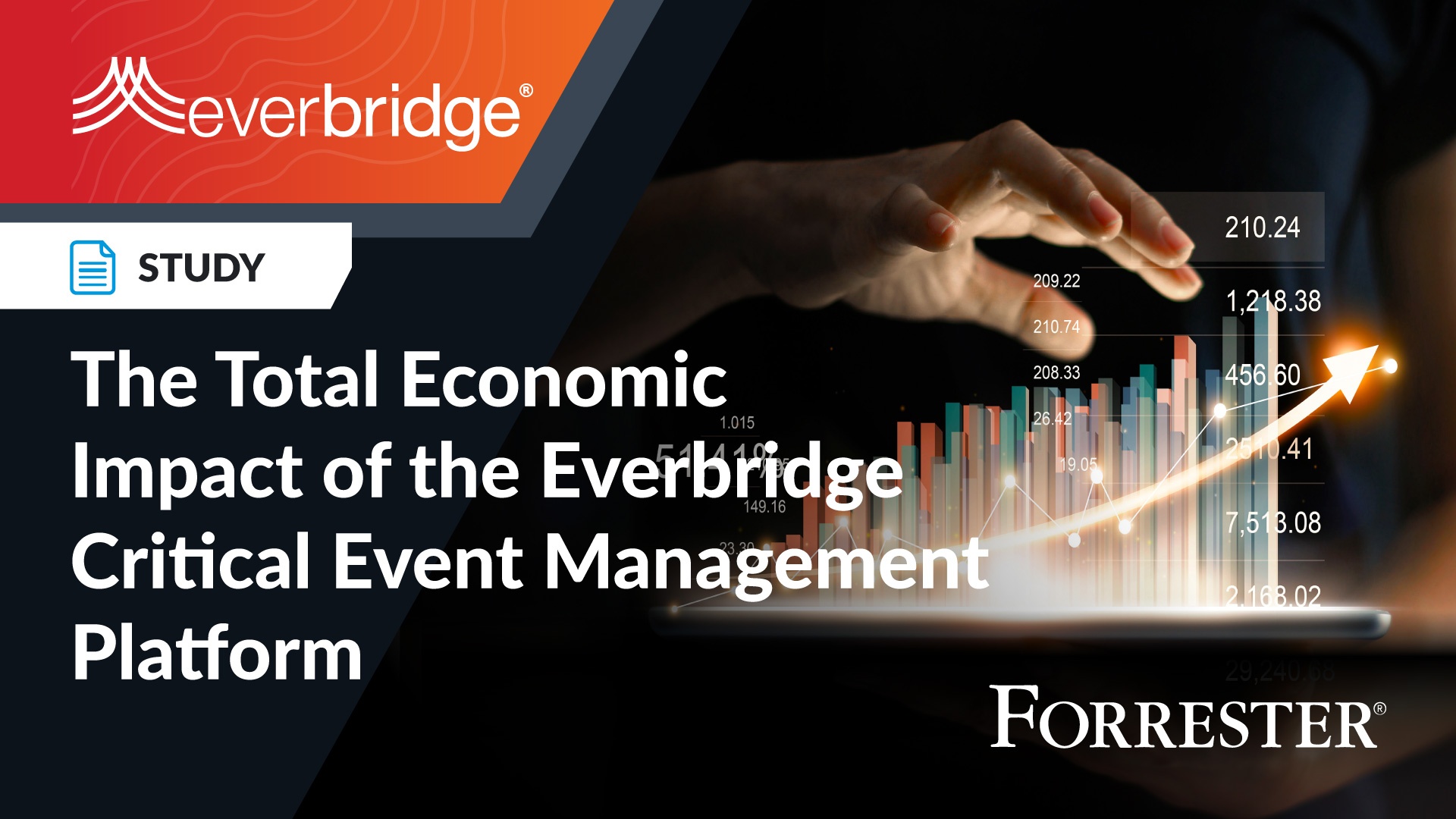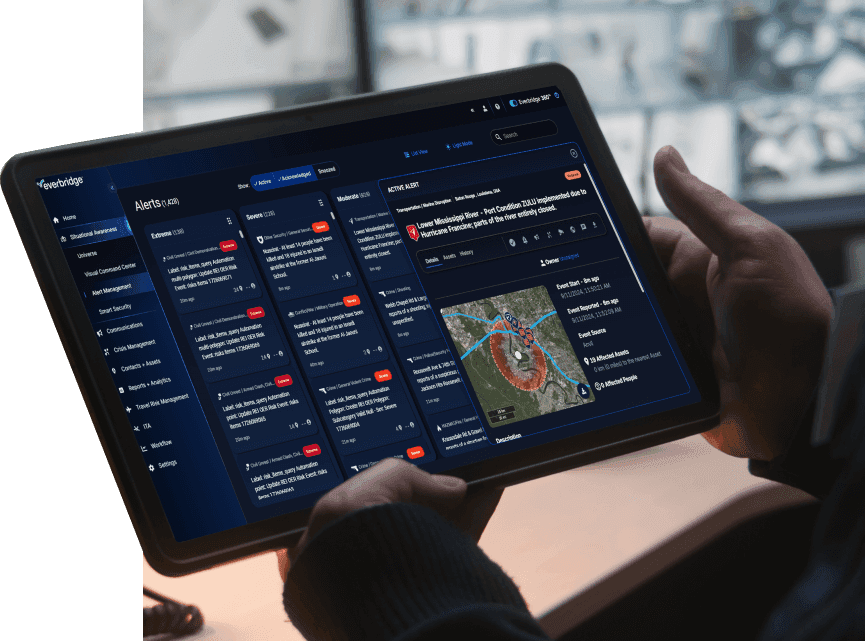Independent Study Finds Everbridge Critical Event Management (CEM) Solution Leads to Significant Business Benefits and Cost Savings for Organizations

-
Study Demonstrates that Everbridge Helps its Customers Successfully Mitigate a Wide Range of Natural, Manmade and Digital Crises, and Drives Measurable Return on Investment (ROI)
-
Stakes for Organizations and Governments Remain High, as Experts Expect COVID-19 Pandemic to Reduce Global Economic Output by $8.5 Trillion Over Next Two Years¹
BURLINGTON, Mass. – July 27, 2020 – Everbridge, Inc. (NASDAQ: EVBG), the global leader in critical event management (CEM), today announced the findings of a June 2020 commissioned study conducted by Forrester Consulting, which combined with recent research from the United Nations on the economic impacts from the ongoing COVID-19 pandemic, highlight the importance of CEM for organizations today.
The Forrester study titled The Total Economic Impact™ of The Everbridge Critical Event Management Platform reveals organizations that use Everbridge’s platform respond to, and contain, critical events—including the ongoing pandemic, cyberattacks, IT outages, severe weather, workplace violence, terrorism, or supply chain disruptions—more effectively than those that do not deploy its CEM solution. As a result, Everbridge customers benefit from safer workforces, reductions in property damage, decreases in IT downtime, and increased employee productivity, among other benefits.
The stakes for business, healthcare and government organizations remain especially high as the coronavirus pandemic continues to spread throughout the world amid other crises. “The global economy is expected to lose nearly $8.5 trillion in output over the next two years due to the COVID-19 pandemic, wiping out nearly all gains of the previous four years,” according to a recent United Nations¹ study. The impact of COVID-19 adds to the strain of an estimated $489 billion annual economic impact² resulting from other disruptions, including natural disasters, cyber-attacks, workplace violence and terrorism.
Forrester Consulting Study Highlights Critical Event Management ROI
The companies Forrester interviewed include industry leaders across multiple verticals, such as retail, insurance, healthcare and manufacturing. The study found that Everbridge CEM customers benefit from improved security for employees at all levels, better customer experiences for their end users, and increased investor and regulatory confidence in the organizations’ proactive approach to risk.
The companies interviewed confirmed the following quantifiable benefits:
- Reduced losses from business interruption
- Lowered costs from IT downtime
- Decreased losses from property damage
- Averted costs of lost employee productivity
- Increased security team productivity through freed up time for higher-value tasks
The study also notes that interviewed executives told Forrester that Everbridge helped them: “maintain business operations and revenue during critical events; react to unpredictable events more quickly and confidently; and put appropriate plans in place for events (such as a hurricane) that were more predictable. Because Everbridge uses an organization’s unique asset footprint to determine which incoming news and risk feeds to analyze, [an organization’s] security analysts do not waste time sorting through irrelevant alerts and can react more quickly to situations that pose a real threat to their assets.”
Over 5,200 global firms rely on Everbridge to keep their people safe and organizations running in anticipation of, or amid, critical events, whether natural, cyber, or manmade. The Everbridge CEM solution provides an integrated, end-to-end approach for helping organizations assess the severity of events; determine their relevance to people, assets, suppliers, and supply chains; automate actions and workflows to mitigate threats and track progress; and analyze performance to improve future response. The Everbridge CEM Platform leverages 225 out-of-the-box, pre-existing integrations and 22,000 risk data sources to digitally transform how organizations effectively keep employees safe and their operations, IT systems and supply chains running.
“Today’s multinational organizations require a unified approach to mitigating critical events, from the COVID-19 pandemic and severe weather to cyber-attacks and more,” said Ajay Nigam, Chief Product Officer, Everbridge. “The Forrester Consulting Total Economic Impact study demonstrates that Everbridge CEM provides a significant and measurable return to mitigating risk, keeping people safe and operations running, and helping organizations use business resilience as a competitive advantage.”
For more details on the study, please visit The Total Economic Impact™ of The Everbridge Critical Event Management Platform landing page here.
Forrester Consulting also published an Opportunity Snapshot in 2018 entitled Take A Unified Approach to Critical Event Management that highlighted how an integrated, un-siloed approach helps companies improve operational resilience.
Study Methodology
Forrester has constructed a Total Economic Impact™ (TEI) framework for those organizations considering implementing Everbridge’s Critical Event Management platform. The objective of the framework is to identify the cost, benefit, flexibility, and risk factors that affect the investment decision. Forrester took a multistep approach to evaluate the impact that the Everbridge Critical Event Management platform can have on an organization: 1.) due diligence – interviewed Everbridge stakeholders and Forrester analysts to gather data relative to the Critical Event Management platform; 2.) customer interviews – Interviewed four organizations using Everbridge to obtain data with respect to costs, benefits, and risks; 3.) composite organizations – designed a composite organization based on characteristics of the interviewed organizations; 4.) financial model framework – constructed a financial model representative of the interviews using the TEI methodology and risk-adjusted the financial model based on issues and concerns of the interviewed organizations; and 5.) case study – employed four fundamental elements of TEI in modeling the Everbridge Critical Event Management Platform’s impact: benefits, costs, flexibility, and risks. Given the increasing sophistication that enterprises have regarding ROI analyses related to IT investments, Forrester’s TEI methodology serves to provide a complete picture of the total economic impact of purchase decisions. Please see Appendix A for additional information on the TEI methodology.
¹United Nations World Economic Situation and Prospects (WESP) mid-2020 report – May 13, 2020
²Based on 2016 estimates from Institute for Economics and Peace – 2016 Global Terrorism Index; Munich RE “Overview of Natural Catastrophe Figures for 2016; U.S. Council of Economic Advisors – “The Cost of Malicious Cyber Activity to the U.S. Economy”; National Academies “Costs of Violence in the Workplace”; and United Nations Estimation given 0.5% global economic growth, as of March 9, 2020
About Everbridge
Everbridge, Inc. (NASDAQ: EVBG) is a global software company that provides enterprise software applications that automate and accelerate organizations’ operational response to critical events in order to Keep People Safe and Businesses Running™. During public safety threats such as active shooter situations, terrorist attacks or severe weather conditions, as well as critical business events including IT outages, cyber-attacks or other incidents such as product recalls or supply-chain interruptions, over 5,200 global customers rely on the company’s Critical Event Management Platform to quickly and reliably aggregate and assess threat data, locate people at risk and responders able to assist, automate the execution of pre-defined communications processes through the secure delivery to over 100 different communication devices, and track progress on executing response plans. The company’s platform sent over 3.5 billion messages in 2019 and offers the ability to reach over 550 million people in more than 200 countries and territories, including the entire mobile populations on a country-wide scale in Australia, Greece, Iceland, the Netherlands, New Zealand, Peru, Singapore, Sweden, and a number of the largest states in India. The company’s critical communications and enterprise safety applications include Mass Notification, Incident Management, Safety Connection™, IT Alerting, Visual Command Center®, Public Warning, Crisis Management, Community Engagement™ and Secure Messaging. Everbridge serves 8 of the 10 largest U.S. cities, 9 of the 10 largest U.S.-based investment banks, 47 of the 50 busiest North American airports, 9 of the 10 largest global consulting firms, 8 of the 10 largest global auto makers, all 4 of the largest global accounting firms, 9 of the 10 largest U.S.-based health care providers, and 7 of the 10 largest technology companies in the world. Everbridge is based in Boston and Los Angeles with additional offices in Lansing, San Francisco, Abu Dhabi, Beijing, Bangalore, Kolkata, London, Munich, New York, Oslo, Singapore, Stockholm and Tilburg. For more information, visit www.everbridge.com, read the company blog, and follow on LinkedIn, Twitter, and Facebook.
Cautionary Language Concerning Forward-Looking Statements
This press release contains “forward-looking statements” within the meaning of the “safe harbor” provisions of the Private Securities Litigation Reform Act of 1995, including but not limited to, statements regarding the anticipated opportunity and trends for growth in our critical communications and enterprise safety applications and our overall business, our market opportunity, our expectations regarding sales of our products, our goal to maintain market leadership and extend the markets in which we compete for customers, and anticipated impact on financial results. These forward-looking statements are made as of the date of this press release and were based on current expectations, estimates, forecasts and projections as well as the beliefs and assumptions of management. Words such as “expect,” “anticipate,” “should,” “believe,” “target,” “project,” “goals,” “estimate,” “potential,” “predict,” “may,” “will,” “could,” “intend,” variations of these terms or the negative of these terms and similar expressions are intended to identify these forward-looking statements. Forward-looking statements are subject to a number of risks and uncertainties, many of which involve factors or circumstances that are beyond our control. Our actual results could differ materially from those stated or implied in forward-looking statements due to a number of factors, including but not limited to: the ability of our products and services to perform as intended and meet our customers’ expectations; our ability to successfully integrate businesses and assets that we may acquire; our ability to attract new customers and retain and increase sales to existing customers; our ability to increase sales of our Mass Notification application and/or ability to increase sales of our other applications; developments in the market for targeted and contextually relevant critical communications or the associated regulatory environment; our estimates of market opportunity and forecasts of market growth may prove to be inaccurate; we have not been profitable on a consistent basis historically and may not achieve or maintain profitability in the future; the lengthy and unpredictable sales cycles for new customers; nature of our business exposes us to inherent liability risks; our ability to attract, integrate and retain qualified personnel; our ability to maintain successful relationships with our channel partners and technology partners; our ability to manage our growth effectively; our ability to respond to competitive pressures; potential liability related to privacy and security of personally identifiable information; our ability to protect our intellectual property rights, and the other risks detailed in our risk factors discussed in filings with the U.S. Securities and Exchange Commission (“SEC”), including but not limited to our Annual Report on Form 10-K for the year ended December 31, 2019 filed with the SEC on February 28, 2020. The forward-looking statements included in this press release represent our views as of the date of this press release. We undertake no intention or obligation to update or revise any forward-looking statements, whether as a result of new information, future events or otherwise. These forward-looking statements should not be relied upon as representing our views as of any date subsequent to the date of this press release.
All Everbridge products are trademarks of Everbridge, Inc. in the USA and other countries. All other product or company names mentioned are the property of their respective owners.
Everbridge Contacts
Jeff Young
Media Relations
jeff.young@everbridge.com
781-859-4116
Joshua Young
Investor Relations
joshua.young@everbridge.com
781-236-3695
